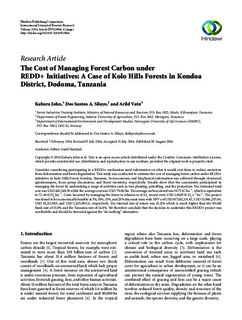| dc.description.abstract | Countries considering participating in a REDD+ mechanism need information on what it would cost them to reduce emissions
fromdeforestation and forest degradation. This study was conducted to estimate the cost ofmanaging forest carbon under REDD+
initiatives in Kolo Hills Forest, Kondoa, Tanzania. Socioeconomic and biophysical information was collected through structured
questionnaires, focus group discussions, and forest inventory, respectively. Results show that the community participated in
managing the forest by undertaking a range of activities such as tree planting, patrolling, and fire protection.The estimated total
cost was USD 418,349.38 while the average cost was USD 79.06/ha.The average carbon stored was 19.75 tC ha−1, which is equivalent
to 72.48 tCO2 ha−1. Costs incurred by managing the forest in relation to tCO2 stored were USD 1.0485 tCO2 e−1ha−1. The project
was found to be economically feasible at 5%, 10%, 15%, and 20% discount rates withNPVs ofUSD107,102,331.83,USD33,986,255.86,
USD 10,312,945, and USD 1,245,905.11, respectively. The internal rate of return was 21.21% which is much higher than the World
Bank rate of 15.8% and the Tanzania rate of 14.8%. We therefore conclude that the decision to undertake this REDD+ project was
worthwhile and should be favoured against the “do nothing” alternative. | nb_NO |

